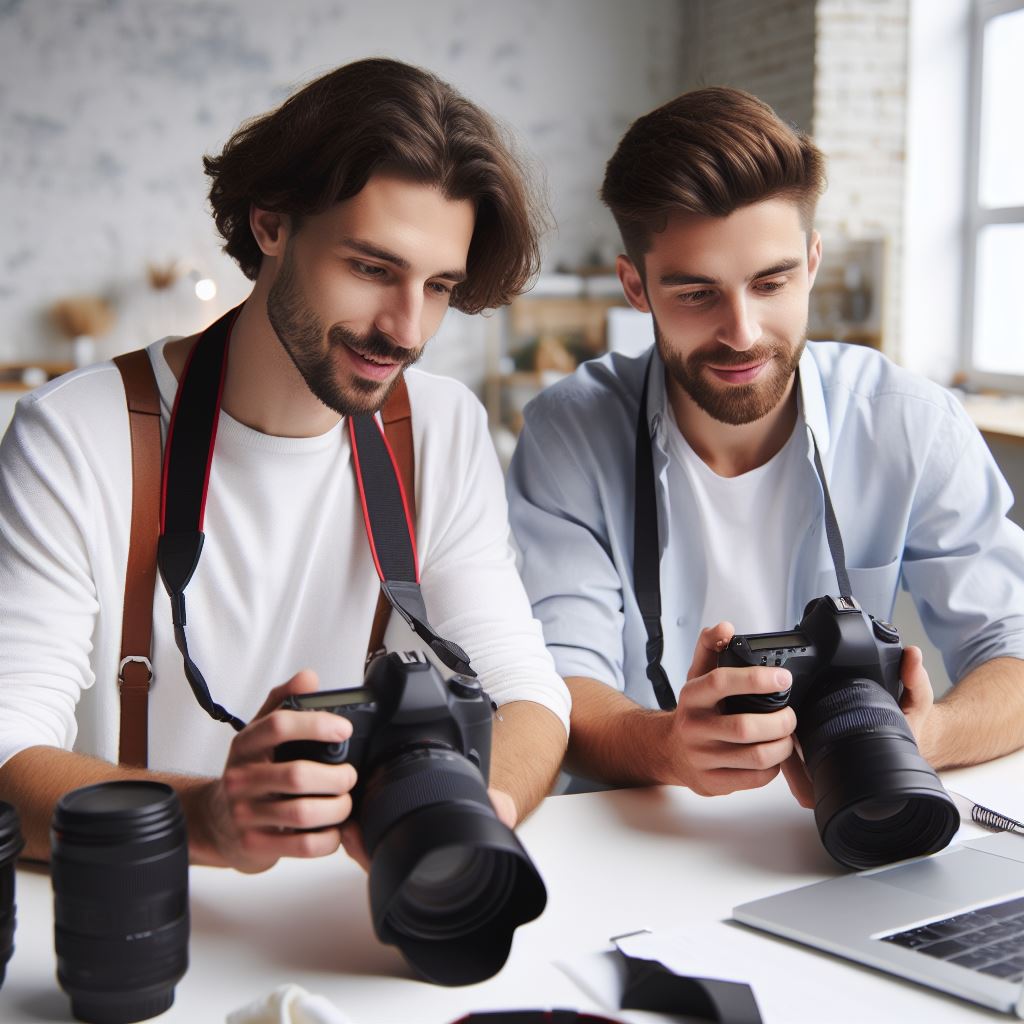Introduction
Mobile photography has become increasingly popular in Australia, fueled by the convenience and accessibility of smartphones for capturing stunning images.
The trend of using smartphones for photography has swept the nation, offering amateurs and professionals alike a convenient tool for capturing their creative visions.
The growing popularity of mobile photography in Australia can be attributed to several factors. Firstly, smartphones have become an indispensable part of our lives, always within reach and ready to capture any moment.
With their high-quality cameras and advanced features, smartphones are transforming the way Australians approach photography.
Furthermore, mobile photography provides a convenient alternative to carrying heavy camera equipment. Gone are the days when enthusiasts and professionals needed to lug around cumbersome cameras and lenses.
Smartphones offer a compact and lightweight solution, allowing photographers to capture beautiful images on the go.
The convenience and accessibility of using smartphones for photography
The accessibility of smartphones enhances the popularity of mobile photography even further. Almost everyone owns a smartphone, making it easy for individuals to explore and express their creative potential through photography.
This accessibility has democratized photography, bringing it closer to the masses and sparking a wave of visual storytelling across the country.
Additionally, smartphones provide a platform for immediate sharing and feedback. Australians can capture a remarkable image and instantly share it with friends, family, or a global online community.
This instant gratification and engagement drive individuals to hone their photography skills and seek validation and appreciation for their work.
In closing, mobile photography has gained immense popularity in Australia due to the convenience and accessibility offered by smartphones.
This trend has revolutionized the way Australians approach photography, empowering individuals to capture and share their creative visions with ease.
Choosing the Right Smartphone for Photography
Having a smartphone with a good quality camera is crucial for capturing stunning photographs. Some of the latest smartphones known for their excellent camera capabilities include the iPhone 12 Pro, Google Pixel 5, and Samsung Galaxy S21.
When selecting a smartphone for photography purposes, consider the following features:
- Camera resolution: Opt for a smartphone with a higher megapixel count for sharper and more detailed images.
- Aperture size: Look for smartphones with a wider aperture size to capture more light, especially in low-light conditions.
- Image stabilization: Optical or electronic image stabilization helps reduce blur caused by camera shake, resulting in clearer photos.
- Low-light performance: Check if the smartphone has a dedicated night mode or larger pixel size to improve low-light photography.
- Zoom capabilities: Consider smartphones with optical zoom capabilities for capturing distant subjects without sacrificing image quality.
- Pro shooting modes: Look for smartphones that offer manual controls, allowing you to adjust settings like ISO, shutter speed, and white balance.
- Post-processing software: Some smartphones have advanced built-in editing tools or compatibility with popular photography apps.
- Battery life: Photography can be battery-intensive, so choose a smartphone with a long-lasting battery or quick charging capabilities.
- Storage capacity: Ensure the smartphone has sufficient storage space for storing your high-resolution photos and videos.
- Display quality: A smartphone with a high-resolution and color-accurate display will allow you to view your photos in their full glory.
- Brand reputation: Consider reputable smartphone brands known for their camera technology and software updates for better long-term performance.
With these features in mind, you can make an informed decision and choose a smartphone that suits your photography needs.
Understanding the Camera Settings
When it comes to mobile photography, understanding the camera settings on your smartphone can greatly enhance your photography skills. Here are some important settings to consider and tips on how to utilize them effectively:
Camera Settings
- Exposure: Adjusting the exposure setting allows you to control the brightness or darkness of your photos. Experiment with different exposure levels to achieve the desired lighting.
- White Balance: White balance determines the overall color temperature of your photos. Ensure accurate color representation by setting the white balance according to the lighting conditions.
- Focus: The focus setting helps you ensure that the subject of your photo appears sharp and clear. Tap on the screen to manually adjust the focus and tap again to capture the photo.
- HDR (High Dynamic Range): HDR captures multiple photos at different exposure levels and combines them to create a well-balanced image. Enable HDR to capture photos with a wider range of details and vibrant colors.
Importance of Understanding and Utilizing Camera Settings:
By understanding and utilizing these camera settings effectively, you can take your mobile photography to the next level:
- Improved Control: Knowing how to adjust settings like exposure and white balance empowers you to have greater control over your photos’ aesthetic qualities.
- Enhanced Creativity: Utilizing camera settings allows you to experiment with different effects, tones, and moods, expanding your creative possibilities.
- Professional-Like Results: Mastering camera settings helps you capture professional-looking photos that showcase your skills and creativity.
- Capturing Challenging Scenes: Understanding focus and HDR settings helps you capture detailed photos in challenging lighting conditions or high-contrast scenes.
Tips for Adjusting Camera Settings
Here are some tips to optimize specific camera settings for better mobile photography:
- Exposure: Increase exposure for brighter scenes, decrease for darker scenes. Experiment to find the perfect balance.
- White Balance: Use the auto mode for general situations, but consider adjusting it manually for specific lighting conditions (e.g., warm or cool tones).
- Focus: Utilize the tap-to-focus feature to ensure sharpness on the subject, especially in portrait or macro photography.
- HDR: Enable HDR mode for landscape or high-contrast scenes to capture balanced photos with excellent details.
Remember, practice is essential to familiarize yourself with your smartphone camera settings. Experimenting with different settings in various conditions will help you understand their impact on your photos.
So get out there, explore these settings, and unleash your creativity through mobile photography!
Read: Australian Music Awards: A Closer Look
Composition and Framing
Importance of composition in photography
The composition is crucial as it determines the overall visual impact of the photograph.
Your Personalized Career Strategy
Unlock your potential with tailored career consulting. Get clear, actionable steps designed for your success. Start now!
Get StartedRule of thirds
The frame into nine equal parts using two horizontal and two vertical lines. Place the subject along these lines or at their intersections for a balanced composition.
Leading lines
Utilize lines in the image such as roads, rivers, or buildings to lead the viewer’s eye towards the main subject. This creates a sense of depth and draws attention to the focal point.
Framing the subject
Use elements in the environment to frame the subject, creating a natural border that directs the viewer’s attention towards the main focus of the image.
Visually appealing compositions
Experiment with different angles, perspectives, and distances to create visually interesting compositions that captivate the viewer.
Balance in composition
Avoid placing the subject in the center of the frame. Instead, use the rule of thirds to achieve balance and create a more dynamic composition.
Symmetry and patterns
Symmetrical compositions can create a sense of harmony and balance in the image. Look for patterns or repetitive elements to add visual interest.
Negative space
Sometimes, leaving empty space around the subject can enhance the composition, drawing attention to the main subject and creating a sense of simplicity and minimalism.
Framing with natural surroundings
Incorporate elements of nature, such as trees, leaves, or branches, to frame the subject and add depth and context to the photograph.
Experiment with different compositions
Don’t be afraid to try different angles, perspectives, and compositions to find the most visually striking result.
Leading lines in landscapes
Use naturally occurring lines, like paths or rivers, to guide the viewer’s eye through the photograph and create a sense of depth and dimension.
Framing with architecture
Utilize architectural elements, such as doorways, windows, or arches, to frame the subject and add a unique visual element to the composition.
Balance between foreground and background
Pay attention to both the subject and the background. Ensure they complement each other and create a harmonious composition.
Rule of odds
When photographing multiple subjects, an odd number of subjects tends to create a more visually appealing and balanced composition compared to an even number.
Experiment with unconventional compositions
Break the rules and try out unconventional compositions to create unique and striking images.
Stand Out with a Resume That Gets Results
Your career is worth more than a generic template. Let us craft a resume and cover letter that showcase your unique strengths and help you secure that dream job.
Get HiredContinual learning
Photography is an art form that requires practice and constant learning. Keep experimenting and refining your composition skills to improve over time.
By following these composition and framing tips, Australian mobile photographers can enhance their photographs and create visually stunning and captivating images.
Remember, practice makes perfect, so keep exploring and experimenting with different compositions to find your own unique style.
Read: The Evolution of Australian Music Genres
Lighting Techniques
Lighting is one of the most crucial aspects of photography as it dramatically affects the outcome and overall quality of your images.
Different lighting conditions can create various moods, highlight specific details, and even alter the color tones in your photos. To capture stunning mobile photographs, it is essential to understand the significance of lighting and utilize it effectively.
Here are some tips for capturing photos in different lighting conditions:
Natural Light
- Utilize the golden hour, which occurs during the first or last hour of sunlight, for soft and warm lighting.
- Avoid harsh shadows by positioning your subject in the shade or using a diffuser to soften the light.
- Experiment with the direction of light for different effects, such as backlighting to create silhouettes.
- Take advantage of reflections from surfaces like water or glass to add depth and interest to your composition.
Low Light
- Keep your hands steady and minimize camera shake by using a tripod or resting your phone on a stable surface.
- Adjust the ISO settings on your mobile phone to increase the sensor’s sensitivity to light, but beware of introducing digital noise.
- Experiment with long exposure techniques to capture light trails or create artistic blurs.
- Use the available light sources intelligently, such as streetlights, candles, or neon signs, to add ambiance to your photos.
Backlight
- Employ the exposure compensation feature on your phone to compensate for the strong backlight and prevent underexposure.
- Use the smartphone’s HDR mode to balance the exposure between the bright background and the subject in the foreground.
- Consider using a reflector or fill flash to add light to the subject and avoid silhouette effects.
- Create a captivating silhouette by exposing for the background and positioning your subject against the bright light.
Artificial Lighting Solutions and Accessories
- Experiment with external lighting sources such as portable LED panels, ring lights, or clip-on smartphone lights.
- Attach lens attachments with built-in LED lights to add extra illumination and enhance your mobile photography.
- Use colored gels or filters to alter the light temperature and create unique and atmospheric effects.
- Explore the versatility of smartphone photography by experimenting with light painting techniques and creative light trails.
Mastering lighting techniques in mobile photography requires practice and a keen eye for detail.
Understanding how different lighting conditions affect the mood and overall aesthetics of your photos enables you to make deliberate choices when capturing moments on your mobile device.
So, grab your phone, explore various lighting scenarios, and let your creativity shine!
Read: Music Production: A Guide for Aussies

Editing and Post-processing
When it comes to mobile photography, editing and post-processing play a vital role in enhancing your photos and making them stand out.
With the advancement of technology, there are now numerous photo editing apps available for smartphones that can help you achieve professional-looking results.
Popular Photo Editing Apps for Smartphones
- Adobe Lightroom Mobile: This app offers a wide range of editing tools and presets to enhance your photos.
- VSCO: Known for its trendy filters, VSCO provides various editing options and a social platform for photographers to share their work.
- Snapseed: Developed by Google, Snapseed offers a comprehensive set of editing tools including selective adjustments and filters.
- Afterlight: This app features a minimalist design and provides a variety of filters, textures, and tools for editing.
- TouchRetouch: With this app, you can remove unwanted objects or blemishes from your photos with just a few taps.
Tips for Enhancing Photos through Editing
- Adjust Exposure: Increase or decrease the exposure to correct overexposed or underexposed areas in your photo.
- Enhance Contrast: Increase the contrast to make the elements in your photo pop and create a more dynamic look.
- Increase Saturation: Boosting the saturation can make colors appear more vibrant and eye-catching.
- White Balance Adjustment: Correct the white balance to ensure accurate colors and eliminate unwanted color casts.
- Crop and Straighten: Use cropping and straightening tools to improve composition and remove any unwanted distractions.
Importance of Maintaining a Natural and Realistic Look
While editing photos, it’s essential to maintain a natural and realistic look to avoid over-processing and creating artificial-looking images.
Here are a few tips to achieve a natural look:
- Don’t overdo the filters: Use filters sparingly, or opt for subtle adjustments that enhance the photo without making it look unnatural.
- Avoid excessive retouching: While it’s okay to remove small imperfections, be cautious not to completely alter the subject’s appearance.
- Keep it balanced: Strive for a balanced exposure, contrast, and saturation to retain a natural appearance.
- Preserve details: Avoid losing details by not increasing the sharpness or clarity excessively.
Basically, editing and post-processing are crucial steps in mobile photography. With the availability of various photo editing apps, you can easily enhance your images and make them visually appealing.
However, it’s important to strike a balance and maintain a natural and realistic look to create captivating photos that truly represent your artistic vision.
Read: How to Network in Australia’s Music Scene
See Related Content: How to Ace Auditions: A Guide for Aussie Actors
Tips for Mobile Photography in Australian Settings
When it comes to mobile photography in Australia, there are plenty of unique opportunities to capture stunning landscapes, wildlife, and cityscapes.
However, it’s important to respect the local wildlife and environment while taking photos. Here are six tips to help you make the most of your mobile photography in Australia:
Research Your Location
Before heading out to capture Australian settings, take the time to research your location. Look for well-known spots that offer unique perspectives and take note of any specific regulations or permits required for photography.
Transform Your LinkedIn for Maximum Impact
Elevate your professional brand with a LinkedIn profile that attracts recruiters, showcases your expertise, and maximizes opportunities. Stand out in your industry with a profile built for success.
Boost ProfileUse Natural Light to Your Advantage
Australia is known for its bright and vibrant sunlight. Utilize the natural light to enhance your mobile photography. Experiment with shooting during golden hour, which occurs around sunrise and sunset, to add warmth and depth to your shots.
Embrace the Australian Landscapes
Australia boasts diverse landscapes, from the iconic Outback to pristine beaches and lush rainforests. When capturing these landscapes, focus on highlighting their unique features and capturing the vastness and beauty of the Australian nature.
Get Up Close to Wildlife (Safely!)
Australia is home to unique and captivating wildlife such as kangaroos, koalas, and colorful birds. When photographing wildlife, remember to keep a safe distance and respect their habitats.
Use a zoom lens to capture close-up shots without disturbing the animals.
Experiment with Cityscapes
Don’t overlook Australia’s vibrant cityscapes. Capture the hustle and bustle of cities like Sydney or Melbourne, or explore the unique architectural features of smaller towns.
Look for interesting angles and reflections to make your cityscape photos standout.
Respect the Environment
While capturing incredible photos, it’s vital to respect the local environment and wildlife. Avoid feeding or approaching wild animals, and be mindful of fragile ecosystems.
Consider joining local conservation efforts or supporting organizations that work towards preserving Australia’s natural beauty for future generations.
To conclude, mobile photography in Australian settings offers a plethora of opportunities to capture breathtaking images.
By following these six tips and respecting the environment, you can create stunning photographs while preserving the beauty of Australia for years to come.
Conclusion
To recap the tips and techniques mentioned throughout this blog post, we have explored various ways to improve mobile photography skills.
From understanding composition and lighting to utilizing editing tools, these tips can enhance the quality of your photos.
It is important for readers to practice and explore their mobile photography skills. By continuously experimenting and learning, one can grow their abilities in capturing beautiful moments with their mobile devices.
Additionally, showcasing Australian beauty through mobile photography on social media platforms holds significant power. The images captured can highlight the unique landscapes, wildlife, and cultural experiences that Australia has to offer.
Sharing these photos with a larger audience not only promotes the beauty of the country but also encourages others to visit and explore.
So, embrace the power of mobile photography and let your creativity shine through your shots. Capture the essence of Australia and share it with the world on social media platforms.
With practice and exploration, you can master the art of mobile photography and create stunning images that showcase the true beauty of Australia.




